Our guide book says that ‘between April and August we would be crazy’ to come to Jaisalmer because ‘the city becomes hellishly hot’. So we boarded the train for the 6 hour rattle from Jodhpur to the middle of the Thar Desert. Although the guide book is often inaccurate, in this instance the warning was all too true. We stepped off the train into a furnace of 45c (112F) and it was still only 1130am. But we struck lucky with the hotel which had only been opened for 2 years so that essential services, like air conditioning, still worked. Naturally, this did not apply during power cuts, an everyday occurrence, that always happened at the most inconvenient moments. These lasted until some unnamed worker in the power station groped about in the dark and successfully located the correct switch to spring our world back into relative coolness.
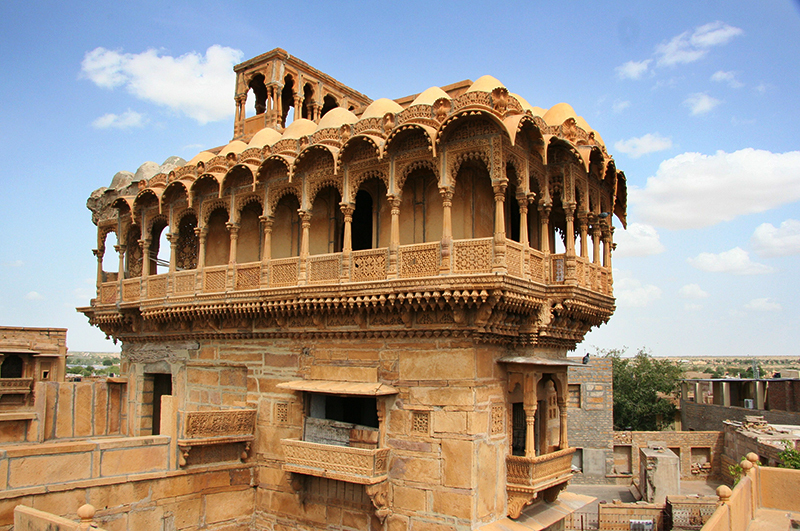 Being so hot, we thought that we would leave a visit to the formidable fort until the following morning and set off to look at some of the town’s Havelis (literal meaning ‘enclosed spaces’ but used to describe rich merchants houses). Jaisalmer has some incredibly fine sculpted sandstone buildings built by successful merchants in the 19th and 20th centuries, partly as a way of showing off their wealth and status. Whole blocks of these houses exist where subsequent building has been added to an existing house by sons and brothers who sole aim was to try to outdo their relatives next door.
Being so hot, we thought that we would leave a visit to the formidable fort until the following morning and set off to look at some of the town’s Havelis (literal meaning ‘enclosed spaces’ but used to describe rich merchants houses). Jaisalmer has some incredibly fine sculpted sandstone buildings built by successful merchants in the 19th and 20th centuries, partly as a way of showing off their wealth and status. Whole blocks of these houses exist where subsequent building has been added to an existing house by sons and brothers who sole aim was to try to outdo their relatives next door.
Not surprisingly, most Havelis reserve their most stunning decoration for the outside so as to show the world how wealthy they are. The entrances are all guarded by stone elephants, being a traditional sign of welcome for all respectable residences. The grandest of the Havelis are made from stone that has no cement or mortar: the stones are manufactured with male/female fixtures and often held in place with iron brackets. The ornate stone fixtures that hang from balconies are made with a screw fixing similar to a light bulb. Essentially, the whole structure could be dismantled and rebuilt as many times as was desired (though there is no evidence this actually happened) and it was a simple enough task to add on extra floors as required (which they often did).
The earliest of these lego-like buildings (called Salim Singh-ki-Havelli) was pieced together 300 years ago by a Prime Minister of the region called Salim Singh. His father had been murdered before him and he took revenge on the perpetrators by murdering them one by one. He doesn’t seem to have been a very popular fellow and his ill treatment of the local Paliwal community (the old ‘tax them till the pips squeak’ trick) led them to abandon their 84 villages and move elsewhere. Eventually, even the Maharajah tired of Salim Singh’s antics and had him murdered. Everyone danced for joy.
The biggest Haveli (Patwa-ki-Haveli) is found towering over a narrow lane, its intricate stonework like honey coloured lace. Built in sections by five brothers who made their fortunes in brocade and jewelry, the inside has been restored and turned into a museum displaying the daily workings of the merchants.
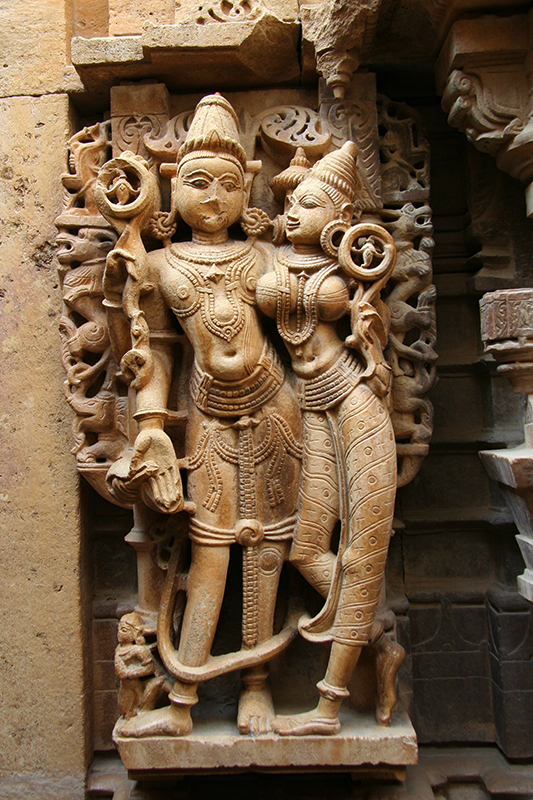 Most of these merchant-Haveli builders were Jains, a small offshoot of the Hindu religion that believe in total non violence, that everything has a soul that should not be destroyed but, nonetheless, they are vegetarian (I suppose they have to eat something). Like their homes, they built fancy temples with intricate and delicate figurines carved into the walls. The gold sandstone from which the temples are made gives a soft, warm texture to the interior but also make it a bit gloomy. The Jains were not as prim as the Hindus and their statues of females are more voluptuous and less clothed. These female figures are tributes to feminine beauty and the importance of carnal desire in human existence. They were an early make-love-not-war outfit but without the rock and roll.
Most of these merchant-Haveli builders were Jains, a small offshoot of the Hindu religion that believe in total non violence, that everything has a soul that should not be destroyed but, nonetheless, they are vegetarian (I suppose they have to eat something). Like their homes, they built fancy temples with intricate and delicate figurines carved into the walls. The gold sandstone from which the temples are made gives a soft, warm texture to the interior but also make it a bit gloomy. The Jains were not as prim as the Hindus and their statues of females are more voluptuous and less clothed. These female figures are tributes to feminine beauty and the importance of carnal desire in human existence. They were an early make-love-not-war outfit but without the rock and roll.
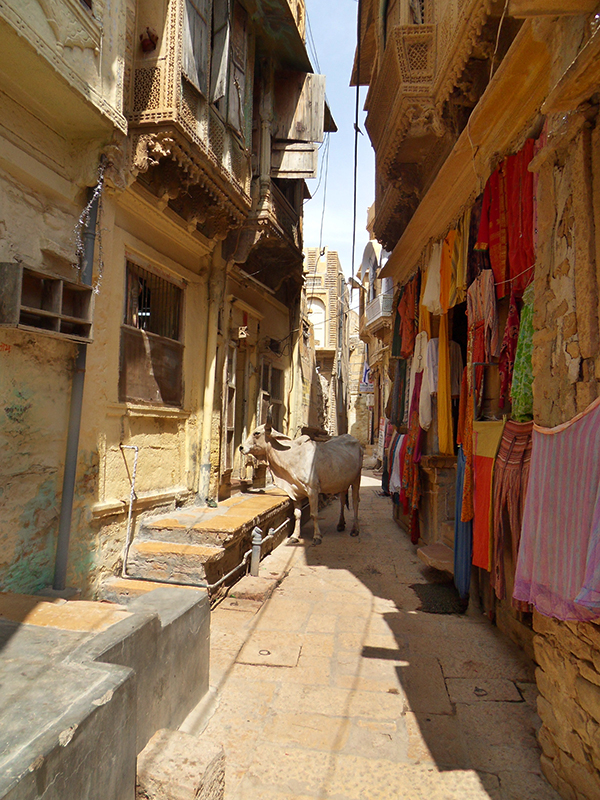 By now the town was really hot and airless. The golden sandstone seems to hold the heat of the sun so that we cannot comfortably lean against it nor sit on it. The narrow streets manage to block out any breeze that might be flowing over the land and the atmosphere is claustrophobically close and unpleasantly hot. It feels as if the air is bereft of oxygen.
By now the town was really hot and airless. The golden sandstone seems to hold the heat of the sun so that we cannot comfortably lean against it nor sit on it. The narrow streets manage to block out any breeze that might be flowing over the land and the atmosphere is claustrophobically close and unpleasantly hot. It feels as if the air is bereft of oxygen.
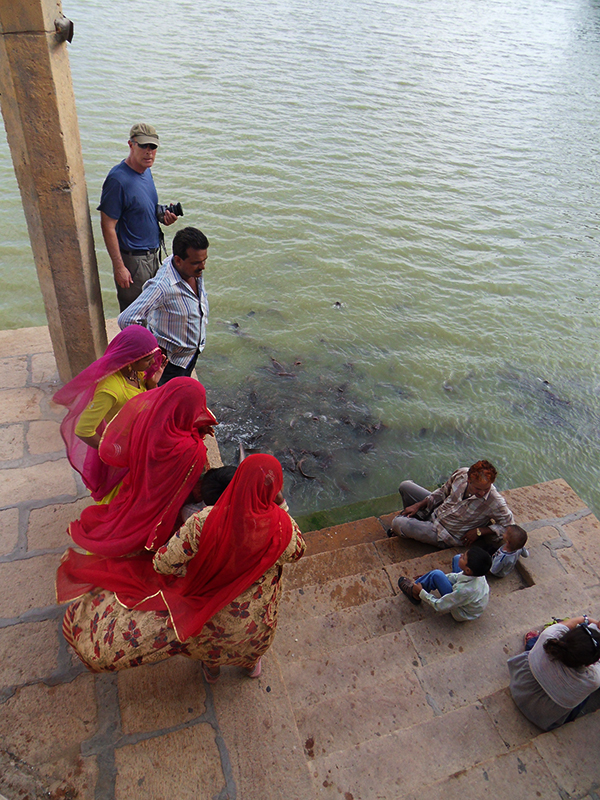 We moved to the Gadi Sagar Lake where we thought it would be cooler but, if it was, it was only marginal. The lake is the water supply of the city and considered holy. It has three or four small man made islands for musicians, dancers and for the Maharaja to dine. It is impressively full of water, the first lake we have seen that is not dry, and the result of a typhoon that moved through the area a few weeks ago. A mass of Catfish crowded around the shores where locals fed them with bread. The lucky creatures are not hunted by fishermen as they reside in holy water. Frankly, I am delighted that they will be off the evening’s menu. Having attempted to eat catfish in Cambodia, I don’t care for them one bit, being incredibly bony and tasteless. Their only useful purpose being as bait for other, more delightful, fare.
We moved to the Gadi Sagar Lake where we thought it would be cooler but, if it was, it was only marginal. The lake is the water supply of the city and considered holy. It has three or four small man made islands for musicians, dancers and for the Maharaja to dine. It is impressively full of water, the first lake we have seen that is not dry, and the result of a typhoon that moved through the area a few weeks ago. A mass of Catfish crowded around the shores where locals fed them with bread. The lucky creatures are not hunted by fishermen as they reside in holy water. Frankly, I am delighted that they will be off the evening’s menu. Having attempted to eat catfish in Cambodia, I don’t care for them one bit, being incredibly bony and tasteless. Their only useful purpose being as bait for other, more delightful, fare.
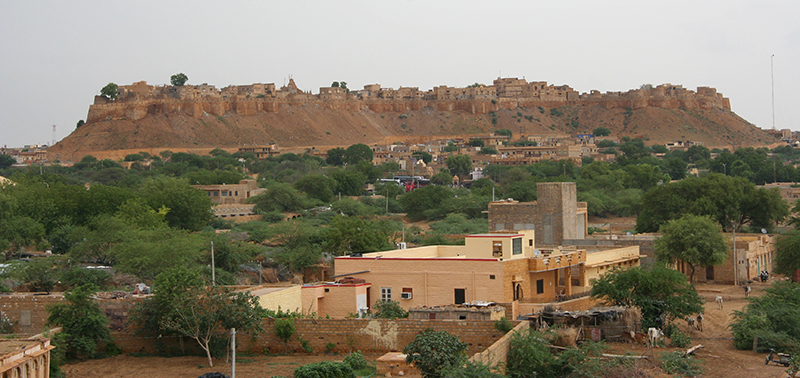 In the morning, before we were roasted alive, we set off for the magnificent fort. It is another glorious sight. It covers the 80 metre high Trikuta (three peaked) Hill and it looks as if time rich hands have swept a pile of sand together before plonking a massive sandcastle on top. It is known as The Golden City for the colour of the sandstone blocks that warm and radiate in the sunshine. Built in 1156, it evokes ancient desert spendour and exotic tales of bravery along one of the most travelled trade routes of its time. Merchant camel caravans stopped here on their way to the East and the Maharajas grew rich on bartering and on taxing the caravans. When that wasn’t enough, they would resort to thievery, cattle rustling and other banditry to pass the time and fill the coffers. This would often get them into trouble with other states who sought revenge for looting their goods.
In the morning, before we were roasted alive, we set off for the magnificent fort. It is another glorious sight. It covers the 80 metre high Trikuta (three peaked) Hill and it looks as if time rich hands have swept a pile of sand together before plonking a massive sandcastle on top. It is known as The Golden City for the colour of the sandstone blocks that warm and radiate in the sunshine. Built in 1156, it evokes ancient desert spendour and exotic tales of bravery along one of the most travelled trade routes of its time. Merchant camel caravans stopped here on their way to the East and the Maharajas grew rich on bartering and on taxing the caravans. When that wasn’t enough, they would resort to thievery, cattle rustling and other banditry to pass the time and fill the coffers. This would often get them into trouble with other states who sought revenge for looting their goods.
One such trouble resulted from the ransacking of a caravan bound for the Imperial palace in Delhi. The Emperor Ala-Uddin Khilji mounted an expedition to retrieve his treasure, laying siege to Jaisalmer Fort for nine years. The odd thing about this was that the soldiers of both sides would fight from dawn until dusk and then meet up for a beer and a friendly game of checkers before returning to their murderous daytime jobs. No wonder the siege went on for so long. In any case, the Emperor’s forces finally gained the upper hand and when the defenders realised that the game was up, they decided on death before dishonor and declared Jauhar (ritual mass suicide). After a night of religious ceremony, they built a big fire and all the women were required to throw themselves into the flames to die. The men then put on their finest saffron robes and rode out of the fort to certain death. This Jauhar has happened two and a half times over the years. The half a time being in 1550, when the defenders of Jaisalmer didn’t have time to burn their women to death, so they cut their throats instead. Apparently, so I am told, it’s always been tough being female.
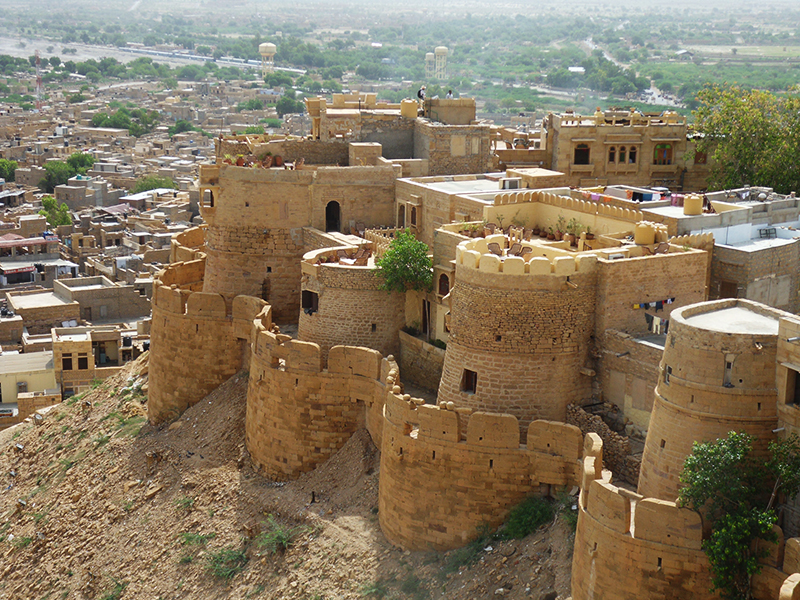 Today the outer wall, with hundreds of linked semi circular turrets, complete with fingers of round bastions above them, contrast with the square buildings inside the city. It is a glorious sight. But one that may not be there for much longer as the soft sandstone on which the fort is built cannot withstand the rigours of modern day living.
Today the outer wall, with hundreds of linked semi circular turrets, complete with fingers of round bastions above them, contrast with the square buildings inside the city. It is a glorious sight. But one that may not be there for much longer as the soft sandstone on which the fort is built cannot withstand the rigours of modern day living.
When it was built, water was a precious commodity and never wasted. Thus, water used to wash vegetables, was then used to cook them and, finally, to water the animals. Alternatively, water used to wash the body, was then used to wash clothes and finally used to wash floors.
As a result, the drainage system never had to carry very much. Nowadays, the huge demand for water that is used once puts the sewer pipes under a pressure that it was never designed to accommodate and, as a result, the soft sandstone is eroding at an alarming rate. Parts of the fort have already collapsed and it is only a matter of time before everything else goes the way of all sandcastles. The situation is not helped by the fact that the lower walls, around the base of the hill, have been pilfered by locals for their own building. Needless to say, the authorities are wondering what is to be done.
The fort differs from all the others we have seen in that a whole community lives within the inner walls. It is packed with narrow streets about 3 metres wide. Houses, temples, handicraft shops, travel agencies, hotels, beauty parlours and all the paraphernalia of tourism jostle for attention in the narrow alleyways. The usual array of determined touts, wallet-emptiers and shysters block our way desperate for business.
The Palace is 7 storeys high and full of small rooms and open courtyards positioned to catch the desert breeze. The Maharaja’s private area is far from opulent, also being small and cramped and decorated with tiles that look as if they have been stolen from a Victorian toilet. Through the fine lattice work, the views look along the fort walls on top of which can still be seen the huge stone balls ready to be rolled on top of an invading army. On the roof top, there are views in all directions across the desert plains as far as the eye can determine. To the West, about 120Km, is Pakistan with whom modern India is always bickering. But wherever, the eye roams, even a small caravan would be easily spotted as it made its way Eastwards. The skyline is littered with Meccano-like towers, some with mobile phone equipment, some with radar and other military bits and pieces and some (shock, horror) with windmills. Even the Indians cannot resist these pathetic pieces of energy generation and seem quite happy to desecrate their countryside with a host of horrible eyesores. More than half of them were stationery.
We rounded off our visit with a desert safari. We clambered into an Indian Jeep and bumped off into the wilderness. We stopped at Bada Bagh to admire the royal chatris (tombs and memorials) of former Maharajas. They are often pictured in carvings riding horses with a headcount of wives next to them. We also stopped at the deserted village of Khaba which Brahmin farmers had left rather than face the taxes of Salim Singh.
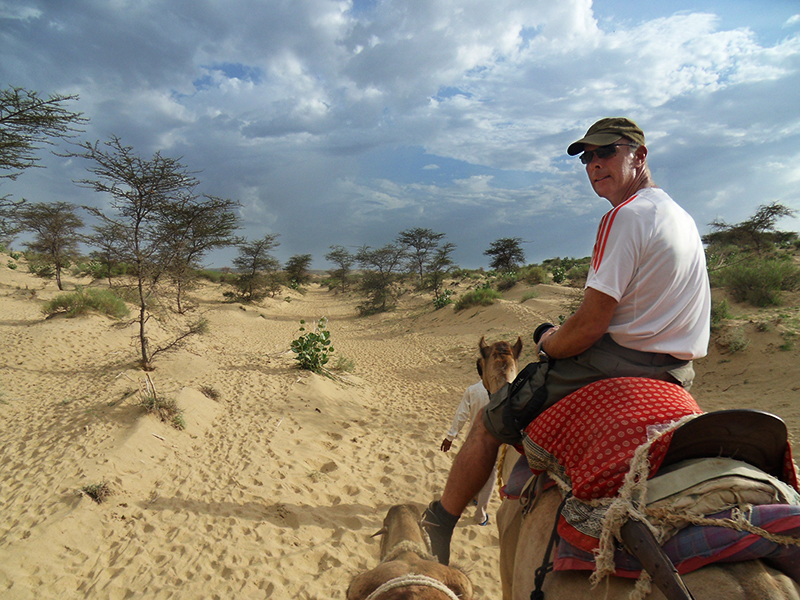 Out here in the harsh desert people existed on herding goat and growing millet. Their round homes were built out of thick mud with long, straw roofs. The landscape was sand and rock on which occasional wiry, green bushes fought for survival. This is a tough, harsh existence for all God’s creations. At this point, we jumped on camels and sat somewhat uncomfortably as the beasts sauntered towards our supper camp. We had been promised a romantic dinner beneath the diamond stars and waning moon of a crystal clear desert sky. A chance to imagine ourselves a Maharaja and his (favourite) wife, wandering amongst his vast lands, being entertained by swirling, bejeweled dancers and the rhythmical beat of the court musicians. What we got was rain. Great rivers falling from the sky. As our camels walked, we could see it coming behind us. The rain was preceded by a cloud of sand whipped up by the herald winds of the storm. Our conversation turned wholly on to the subject of whether we would make it to shelter before the rain (nope) and, if not, how we would keep our cameras dry (under our hats of course).
Out here in the harsh desert people existed on herding goat and growing millet. Their round homes were built out of thick mud with long, straw roofs. The landscape was sand and rock on which occasional wiry, green bushes fought for survival. This is a tough, harsh existence for all God’s creations. At this point, we jumped on camels and sat somewhat uncomfortably as the beasts sauntered towards our supper camp. We had been promised a romantic dinner beneath the diamond stars and waning moon of a crystal clear desert sky. A chance to imagine ourselves a Maharaja and his (favourite) wife, wandering amongst his vast lands, being entertained by swirling, bejeweled dancers and the rhythmical beat of the court musicians. What we got was rain. Great rivers falling from the sky. As our camels walked, we could see it coming behind us. The rain was preceded by a cloud of sand whipped up by the herald winds of the storm. Our conversation turned wholly on to the subject of whether we would make it to shelter before the rain (nope) and, if not, how we would keep our cameras dry (under our hats of course).
As it happened, we made it to shelter without getting too wet as the early rainfall was light. We did get covered in sand which led Debbie to complain that she hadn’t been planning to wash her hair that night. Personally, I could not understand why anyone would not want a thorough head exfoliation before being anointed by soft, pure rain. It’s the type of treatment for which spas around the world charge a fortune.
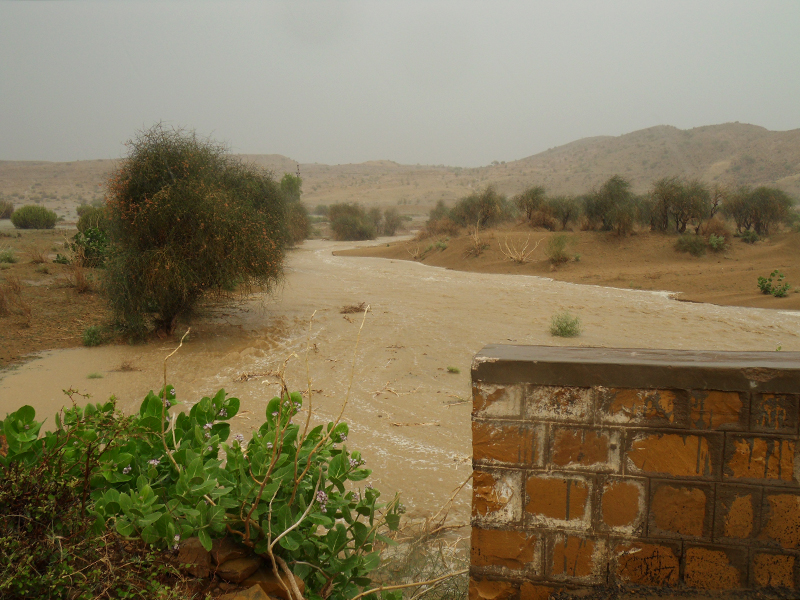 So our romantic dinner got washed out big time. The rain fell in great marble sized drops that exploded into the sand like a small 20 kiloton bomb. The rainwater sat on the landscape, filling the desert as if the whole area would become the sandy bottom of a vast sea. In no time, lakes formed in every depression, rivers appeared from nowhere running furiously, with currents that reshaped the sandy landscape instantly. The weather was determined to get us. If it couldn’t bake us to death, it would drown us as a reasonable alternative. We cowered in our little jeep trying to remain dry while being acquainted with the caterwauling noises of desert love songs being played on the stereo at eardrum bursting levels.
So our romantic dinner got washed out big time. The rain fell in great marble sized drops that exploded into the sand like a small 20 kiloton bomb. The rainwater sat on the landscape, filling the desert as if the whole area would become the sandy bottom of a vast sea. In no time, lakes formed in every depression, rivers appeared from nowhere running furiously, with currents that reshaped the sandy landscape instantly. The weather was determined to get us. If it couldn’t bake us to death, it would drown us as a reasonable alternative. We cowered in our little jeep trying to remain dry while being acquainted with the caterwauling noises of desert love songs being played on the stereo at eardrum bursting levels.
But we had nothing to complain about. The roasting temperatures were driven away to be replaced with hot humidity instead. Mad to come here in July? The guide book was wrong after all.

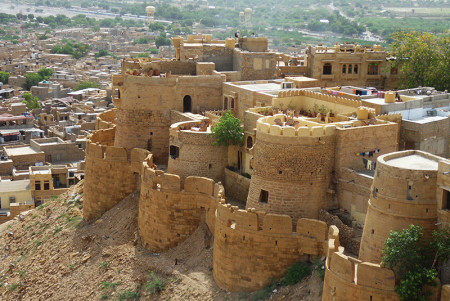
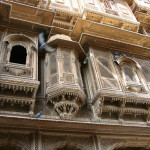
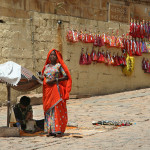
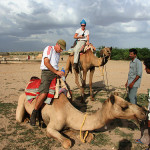
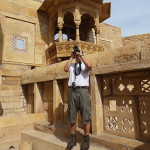
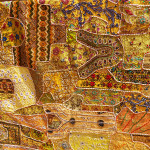
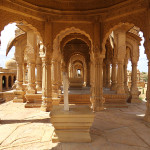
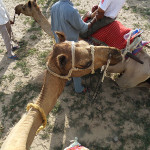
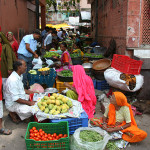
No comments yet.